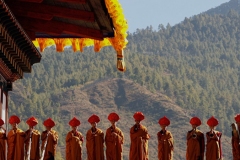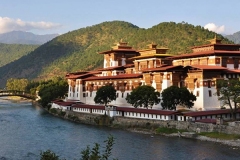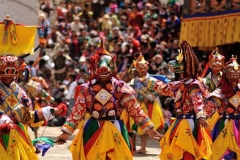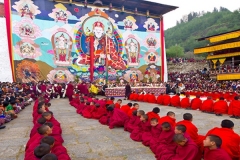Bhutan Central to West Tour
- Tour Overview
- Detailed Itinerary
- Inclusions
- Gallery
Tour Overview
The 10 Day journey will take the visitors to the remote central valleys of Bhutan. In today’s modern times, Bumthang valley has managed to retain all the magic of age old traditions and customs. Legends of great Buddhist saints permeate the valley making it one of the most spiritual destinations in Bhutan. The valley is flooded with sacred monasteries and temples which one can visit during exploring the valley and travelers can experience the glory of this ancient land as embodied in the spectacular fortresses, ancient temples, monasteries and stupas which dot the countryside, prayer flags fluttering above farmhouses and on the hillsides, lush forests, rushing glacial rivers, and perhaps most important of all the warm smiles and genuine friendliness of the people.
Duration: 10 NIGHTS | 11 DAYS
Tour Highlights:
- Hike to Paro Taktsang
- Buddha Dordenma/ Buddha Point
- Tashichodzong – 17th century Fort
- Paro Museum
- Paro Rinpung Dzong
- Punakha Dzong (Fortress)
- The Fertility Temple
- Phobjikha/Gangtey Valley
- Bumthang Valley
- Mebar Tsho ( The Burning Lake)
Trip Route: Thimphu, Punakha, Gangtey, Bumthang, Paro)
Trip at a Glance:
Day 01: Arrive Paro – Thimphu (55km/34mile approx)
Day02: Thimphu (Sightseeing)
Day 03: Drive to Bumthang, Bumthang (Sightseeing)
Day 04: Bumthang (Sightseeing)
Day 05: Drive to Gangtey, Gangtey/Phobjikha (Sightseeing)
Day 06: Drive to Punakha, Punakha (Sightseeing)
Day 07: Punakha (Sightseeing)
Day 08: Drive to Paro, Paro (sightseeing)
Day 09: Paro(Sightseeing)
Day 10: Hike Tiger’s Nest, Paro (Sightseeing)
Day 11: Depart to Bangkok/Delhi/Kathmandu
Detailed Itinerary
Day 1: Arrive at Paro International Airport and Drive to Thimphu
The landing and the taking off of the plane in itself is an amazing experience. As Bhutan is mountainous country the view of mount Jomolhari as the clouds disperse is a magical experience and especially if you are flying from New Delhi and Kathmandu to Paro, you can enjoy an amazing view of Mount Everest. You will need to manage a window seat on the left side of the plane on your flight to Paro. The whole landing experience is like a roller coaster ride on steroids. Once you land, your assigned tour guide and driver will pick up the visitors from the airport and drive to Thimphu city. It will be an hour drive to Thimphu from Paro Airport. After lunch, guests will explore Thimphu City and visit some of the most popular attractions.
Day 2: Thimphu (Sightseeing)
After breakfast, you will be taken around Thimphu city for sightseeing. You will visit popular attractions in Thimphu such as the Statue of Buddha Dordenma, located in Kuensel Phodrang at the top of a hill overlooking the city about 15 minutes drive from the main town. The statue is about 51.5 meters tall making it the tallest sitting statue of Buddha Shakyamuni. Other popular attractions include: The National Memorial Chorten which was built in the memory of the late 3rd king of Bhutan. You will also visit the Motithang Takin Preserve, Jungshi Traditional Paper Factory, Bhutan Postal Museum and many such exciting attractions.
Day 3: Drive to Bumthang
Today you will travel all the way to central Bhutan, the Bumthang valley, often revered as the religious hub of the country. The drive will take you across the Black Mountain Range that divides western and central Bhutan. The drive is quite refreshing as you will drive through winding roads through oak and rhododendron forest and across the Pele-la pass (3,300m), the traditional frontier between east and west. The pass is marked with a large whitewashed stupa and is adorned with prayer flags. You will make a quick stop at Chendebji Chorten. After driving for a few while you will reach the Trongsa district. You will make a quick stop at Trongsa and you may also choose to visit Trongsa Dzong and the National Museum. After driving for about 3 hours you will finally reach Bumthang valley. The road winds steeply up to the pass, then runs down through coniferous forest into a wide, open valley known as the Chumey Chumey Valley is home to Bhutan’s famous Yathra weaving textile. Here you will have a chance to browse the traditional textiles and perhaps see the weavers create their intricate handiwork.
Day 4: Bumthang (Sightseeing)
Today you will further explore Bumthang valley by visiting Kurjey Lhakhang, Jambay Lhakhang, Tamzhing Monastery and Kencho sum Lhakhang. You will also visit the infamous Mebar tsho (Burning Lake) which is just below the main road junction. Legend has it that Terton Pema Lingpa, the reincarnation of Padmasambhava discovered religious treasure in the 12th century. This lake is very sacred and is visited by many Bhutanese during auspicious days to offer butter lamps. The importance of the site is indicated by the extensive array of prayer flags and is considered as one of the most holy places for Buddhist pilgrimage.
Day 5: Drive to Gangtey/Phobjikha valley
After Breakfast you will be driven further towards the central Bhutan to the idyllic Phobjikha valley. The drive will take you along scenic landscapes into forests of bamboo and oak, and just before crossing the Pele La pass, you will be able see the hidden Phobjikha Valley. Gangtey is considered one of the most beautiful valleys in Bhutan (3000m/9800ft).The valley is part of an important nature/ wildlife reserve as it known as the winter home of the rare endangered species of bird; the Black-necked Cranes. These fascinating birds migrate to Bhutan from Tibet in winter and leave by early spring. On arrival, you will visit the Black Necked Crane Center. If you happen to visit the place in winter, you will be able to observe the birds. You will also explore the picturesque Phobjikha valley and visit the Gangtey Monastery.
Day 6: Drive to Punakha
Your journey towards the historic valley of Punakha will take you over the high mountain pass of Dochula Pass at 3,050 meters. A quick stop at the pass will let you enjoy the view and will treat you with fresh mountain air. The pass graces the onlookers with a panoramic view of the towering Himalayan peaks on a clear weather day. The pass is adorned with 108 mini stupas built to mark a significant event in the history of Bhutan. Punakha valley is located in a sub-tropical region with warm summers and pleasant winters. Punakha also served as the capital of Bhutan until 1955 after which the seat of government moved to Thimphu. Punakha still serves as the winter residence for the chief abbot and the central monk body.
Upon arrival in Punakha, the first attraction you will visit is the Chhimi Lhakhang popularly known as the fertility temple. The temple is situated on a hillock overlooking the village of Sopsokha, the quaint temple is dedicated to Lama Drukpa Kuenley; the eccentric Buddhist saint also known as the Divine Madman. Just as the name suggests, the infamous temple is known for blessing childless couples with children. The next attraction you will visit is the Palace of great bliss or the Punakha Dzong. Punakha Dzong is one of the most magnificent fortresses in Bhutan. The fortress is known to give immense happiness to the onlooker, therefore its Dzongkha name Punthang Dewachenpoi Phodrang literally translates to; the palace of great bliss. After that you will visit the longest suspension bridge in Bhutan which is over the Pho chu river, just behind the Dzong.
Day 7: Punakha (Sightseeing)
After having breakfast you will visit some of the attractions in Punakha. Punakha valley offers a multitude of sightseeing opportunities to its visitors. Today’s sightseeing includes: Sangchen Dorji Lhendrup Nunnery, the nunnery is suspended on a ridge with spectacular views of the Punakha and Wangdue valleys. The temple houses a complex for higher studies and meditation hall for about 120 nuns. The nunnery also offers opportunities for the visitors to immerse in meditation and self reflection, experience solitude and observe the simple spiritual lives of the nuns who are detached from the worldly norms. The next attraction on the list is the Nalanda Monastery, the Buddhist monastic school in the western part of the Punakha District. The name Nalanda means “insatiable giving” and comes from the ancient Indian University called the Nalanda. The University is located just below the well-known Talo Monastery and above the Walakha village surrounded by the verdant forest. You can witness the monks who are pursuing higher Buddhist studies and learning English as well. You may interact with the monks and chat with them. They will be more than happy to practice their English language skills with you.
Day 8: Drive to Paro
En route to Paro, a quick stop at the Tachog Lhakhang to visit the Iron Chain Bridge built in the early 15th century by the great iron bridge builder and Poet – Yogi Thangtong Gyalpo (1385-1464). He is also known to have built the Dumtseg Lhakhang in Paro and many iron bridges throughout Bhutan and Tibet. The beautiful Paro valley is revered for a rich culture, picturesque landscape and tales of myths and legends. The valley is adorned with many ancient monasteries. The valley is often known as the gateway to the world and is home to the country’s only international airport.
After reaching, you will be led to your hotel and after lunch, you will be taken around the Paro town. Paro town is made of traditional Bhutanese houses aligned neatly together and the Paro River calmly flows just beside the town. Some of the major attractions you will visit are the; Paro Rinpung Dzong, The National Museum, Kyichu Lhakhang and you will also explore Paro town.
Day 9: Paro (Sightseeing)
A wide valley of Paro enclosed with rice fields at the base of the tallest mountain; Mount Jomolhari is the only region that connects Bhutan to the outside world with its only International Airport. The town itself is an attraction as it stretches over the bank of Pa Chu River bank with clustered typical Bhutanese houses fashioned into modern cafes and craft shops to meet the rising demand of the increasing tourist the valley receives each year. Paro is located at an hour away from the capital city that extends from the river confluence of pa chu river and wang chu river called Chuzom sa. Spending a day or a night in Paro is enough to give visitors from foreign land a jest of the remarkable journey one is about to experience in Bhutan. Paro offers a wide range of tourist attraction like the remarkable Drukgyel fortress, the Dzongdrakha Lhakhang or you could even drive to Chelela pass to enjoy the amazing view from the pass. The pass is one of the highest motorable roads in Bhutan at 3988 meters above sea level.
Day 10: Hike to Tiger’s Nest
Today you will embark on Tiger’s Nest monastery hike. The Tiger’s Nest monastery is the most renowned attraction in the whole country. The spectacular structure is precariously suspended on an edge of a cliff at about 900m above Paro valley. Legend has it that in the 8th century Guru Rinpoche rode on the back of a flying tigress from eastern Bhutan to the current monastery site and meditated in a cave here for several years, hence the name, “Tiger’s Nest”. A hike of about 4 hours is the perfect way to end your trip. The hiking trail will take you through a diverse forest until you reach the monastery. After completing the demanding hike, you will be taken back to you hotel where you will take rest to wear off the fatigue from that arduous hike or perhaps choose to take a hot stone bath which often is deemed as the perfect way to unwind.
Day 11: End of Trip
Depart From Paro.
Inclusions
Inclusions
- ✓ Bhutan visa fee
- ✓ Government royalty & taxes
- ✓ Dedicated English speaking tour guide
- ✓ Dedicated tour vehicle and driver
- ✓ 3-star accommodation (twin sharing)
- ✓ Daily meals (B/L/D)
- ✓ Airport transfers/ all ground transportation
- ✓ Bottled water
- ✓ Entry fees to attraction
Exclusions
- ✘ Flights to and from Bhutan
- ✘ Personal shopping
- ✘ Alcoholic Beverages
- ✘ 4 or 5 star accommodation (supplement charges will apply)
- ✘ Excess luggage
- ✘ Laundry service
- ✘ Travel insurance
- ✘ Tips for guide and driver
Gallery
Why Choose Us
-
The best-experienced guides
-
Great value for money!
-
Tours designed by experts
-
Authentic travel experiences
-
Hassle-Free Booking
-
Socially Responsible
 Crystal Bhutan Travels
Crystal Bhutan Travels



